BUICK PARK AVENUE 1993 Owners Manual
Manufacturer: BUICK, Model Year: 1993, Model line: PARK AVENUE, Model: BUICK PARK AVENUE 1993Pages: 340, PDF Size: 18.17 MB
Page 281 of 340
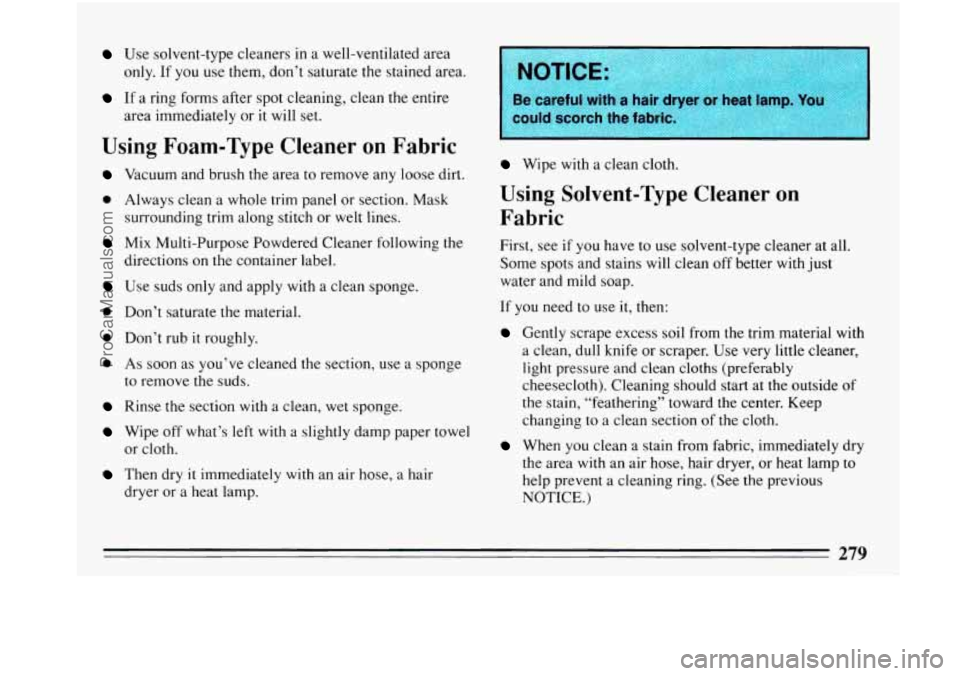
Use solvent-type cleaners in a well-ventilated area
If a ring forms after spot cleaning, clean the entire
only.
If you use them, don’t saturate the stained area.
area immediately or
it will set.
Using Foam-Type Cleaner on Fabric
Vacuum and brush the area to remove any loose dirt.
0 Always clean a whole trim panel or section. Mask
Mix Multi-Purpose Powdered Cleaner following the
Use suds only and apply with a clean sponge.
surrounding
trim along stitch or welt lines.
directions on the container label.
0 Don’t saturate the material.
0 Don’t rub it roughly.
0 As soon as you’ve cleaned the section, use a sponge
to remove
the suds.
Rinse the section with a clean, wet sponge.
Wipe off what’s left with a slightly damp paper towel
or cloth.
Then dry it immediately with an air hose, a hair
dryer or a heat lamp.
e careful with a hair dry
Wipe with a clean cloth.
Using Solvent-Type Cleaner on
Fabric
First, see if you have to use solvent-type cleaner at all.
Some spots and stains will clean
off better with just
water and mild soap.
If you need to use it, then:
Gently scrape excess soil from the trim material with
a clean, dull knife or scraper. Use very little cleaner,
light pressure and clean cloths (preferably
cheesecloth). Cleaning should start at
the outside of
the stain, “feathering” toward the center. Keep
changing
to a clean section of the cloth,
the area with an air hose, hair dryer, or heat lamp to
help prevent a cleaning ring. (See the previous
NOTICE.)
When you clean a stain from fabric, immediately dry
ProCarManuals.com
Page 282 of 340
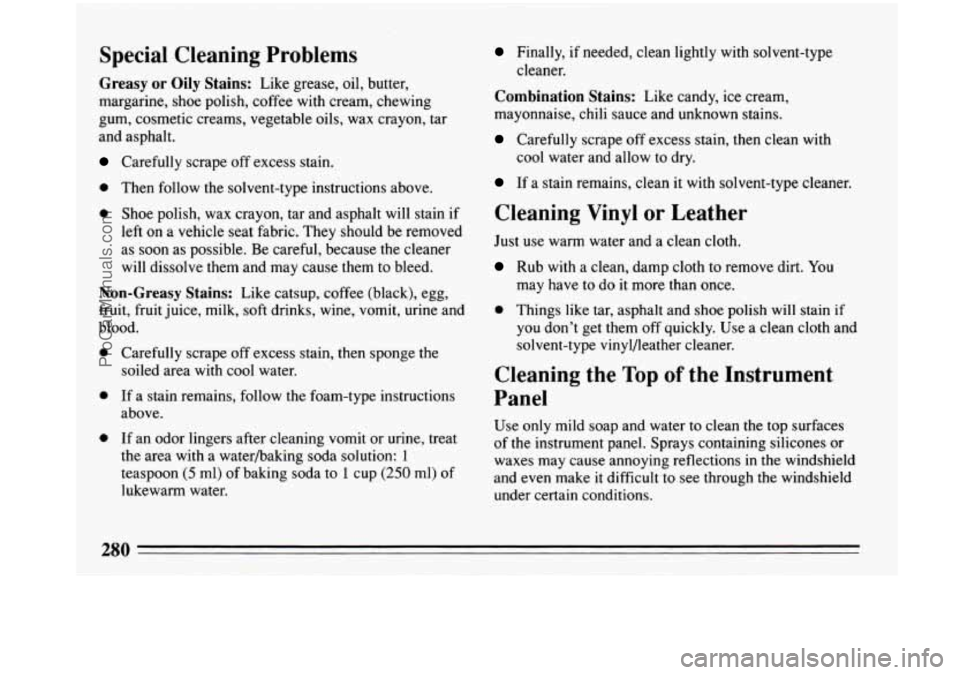
Special Cleaning Problems
Greasy or Oily Stains: Like grease, oil, butter,
margarine, shoe polish, coffee with cream, chewing
gum, cosmetic creams, vegetable oils, wax crayon, tar
and asphalt.
Carefully scrape off excess stain.
0 Then follow the solvent-type instructions above.
0 Shoe polish, wax crayon, tar and asphalt will stain if
left on a vehicle seat fabric. They should be removed
as soon as possible. Be careful, because the cleaner
will dissolve them and may cause them
to bleed.
Non-Greasy Stains: Like catsup, coffee (black), egg,
fruit, fruit juice, milk, soft drinks, wine, vomit, urine and
blood.
0
0
0
Carefully scrape off excess stain, then sponge the
soiled area with cool water.
If a stain remains, follow the foam-type instructions
above.
If an odor lingers after cleaning vomit or urine, treat
the area with a waterbaking soda solution: 1
teaspoon (5 ml) of baking soda to 1 cup (250 ml) of
lukewarm water.
Finally, if needed, clean lightly with solvent-type
Combination Stains: Like candy, ice cream,
mayonnaise, chili sauce and unknown stains.
Carefully scrape off excess stain, then clean with
If a stain remains, clean it with solvent-type cleaner.
cleaner.
cool water and allow
to dry.
Cleaning Vinyl or Leather
Just use warm water and a clean cloth.
Rub with a clean, damp cloth to remove dirt. You
0 Things like tar, asphalt and shoe polish will stain if
may have to do it more than once.
you don’t get them off quickly. Use a clean cloth and
solvent-type vinyl/leather cleaner.
Cleaning the Top of the Instrument
Panel
Use only mild soap and water to clean the top surfaces
of the instrument panel. Sprays containing silicones or
waxes may cause annoying reflections in the windshield
and even make it difficult to see through the windshield
under certain conditions.
ProCarManuals.com
Page 283 of 340
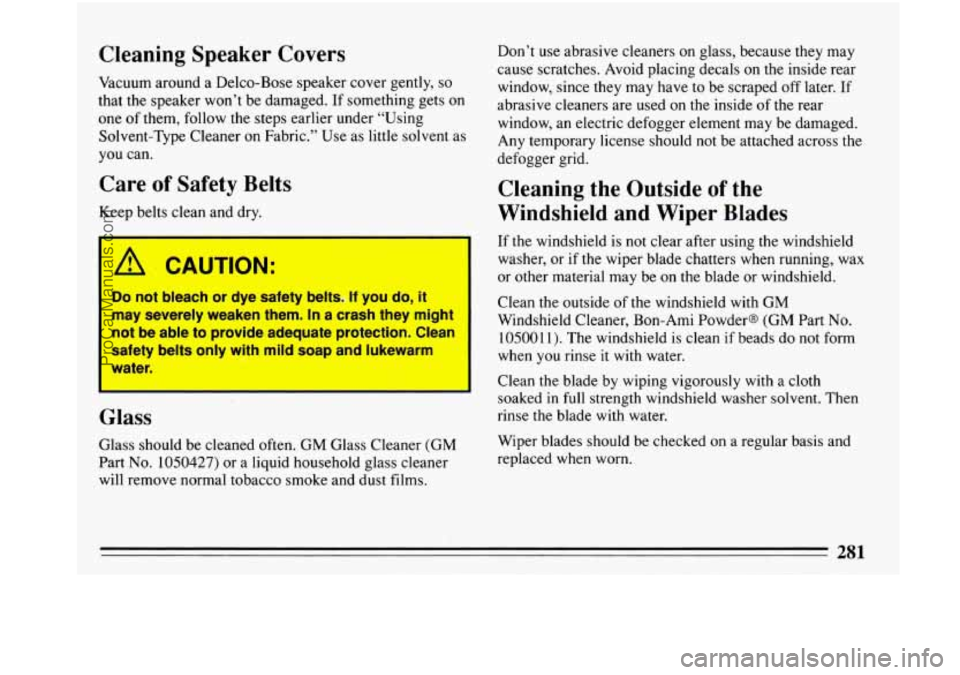
Cleaning Speaker Covers
Vacuum around a Delco-Bose speaker cover gently, so
that the speaker won’t be damaged. If something gets on
one
of them, follow the steps earlier under “Using
Solvent-Type Cleaner on Fabric.” Use as little solvent as
you can.
Care of Safety Belts
Keep belts clean and dry. Don’t
use abrasive cleaners on glass, because they may
caus.e scratches. Avoid placing decals on the inside rear
window, since they may have to be scraped
off later. If
abrasive cleaners are used on the inside of the rear
window, an electric defogger element may be damaged.
Any temporary license should not be attached across the
defogger grid.
Cleaning .the Outside of the
Windshield and Wiper Blades
A CAUTION:
Do not bleach or dye safety belts. If you do, it
may severely weaken them. In a crash they might
not be able to provide adequate protection. Clean
safety belts only with mild soap and lukewarm
I I
Glass
Glass should be cleaned often. GM Glass ueaner (GM
Part
No. 1050427) or a liquid household glass cleaner
will remove normal tobacco smoke and dust films. If
the windshield is not clear after using the windshield
washer, or if the wiper blade chatters when running, wax
or other material may be
on the blade or windshield.
Clean the outside of the windshield with GM
Windshield Cleaner, Bon-Ami Powders (GM Part
No.
105001 1). The windshield is clean if beads do not form
when you rinse it with water.
Clean the blade by wiping vigorously with a cloth
soaked in
full strength windshield washer solvent. Then
rinse the blade with water.
Wiper blades should be checked on
a regular basis and
replaced when worn.
ProCarManuals.com
Page 284 of 340
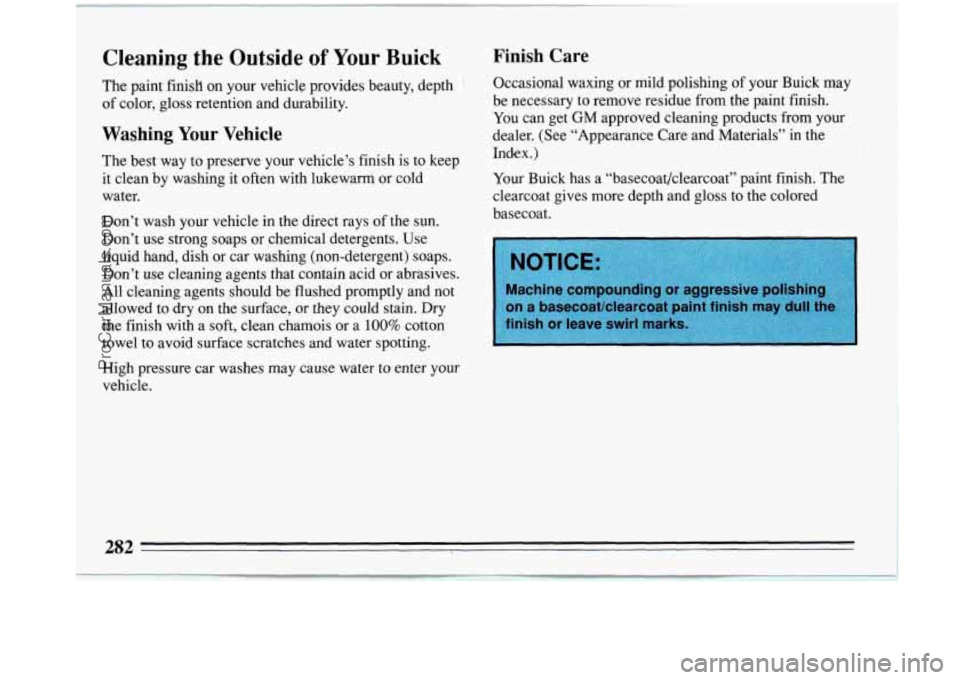
Cleaning the Outside of Your Buick
The paint finisll on your vehicle provides beauty, depth
of color, gloss retention and durability.
Washing Your Vehicle
The best way to preserve your vehicle’s finish is to keep
it clean by washing it often with lukewarm or cold
Water.
Don’t wash your vehicle in the direct rays of the sun.
Don’t use strong soaps or chemical detergents. Use
liquid hand, dish or car washing (non-detergent) soaps.
Don’t use cleaning agents that contain acid or abrasives.
All cleaning agents should be flushed promptly and not
allowed to dry on the surface, or they could stain. Dry
the finish with a soft, clean chamois or a
100% cotton
towel to avoid surface scratches and water spotting.
High pressure car washes may cause water to enter your
vehicle.
Finish Care
Occasional waxing or mild polishing of your Buick may
be necessary to remove residue from the paint finish.
You can get GM approved cleaning products from your
dealer. (See “Appearance Care and Materials” in the
Index .)
Your Buick has a “basecoat/clearcoat” paint finish. The
clearcoat gives more depth and gloss to the colored
basecoat.
282
ProCarManuals.com
Page 285 of 340
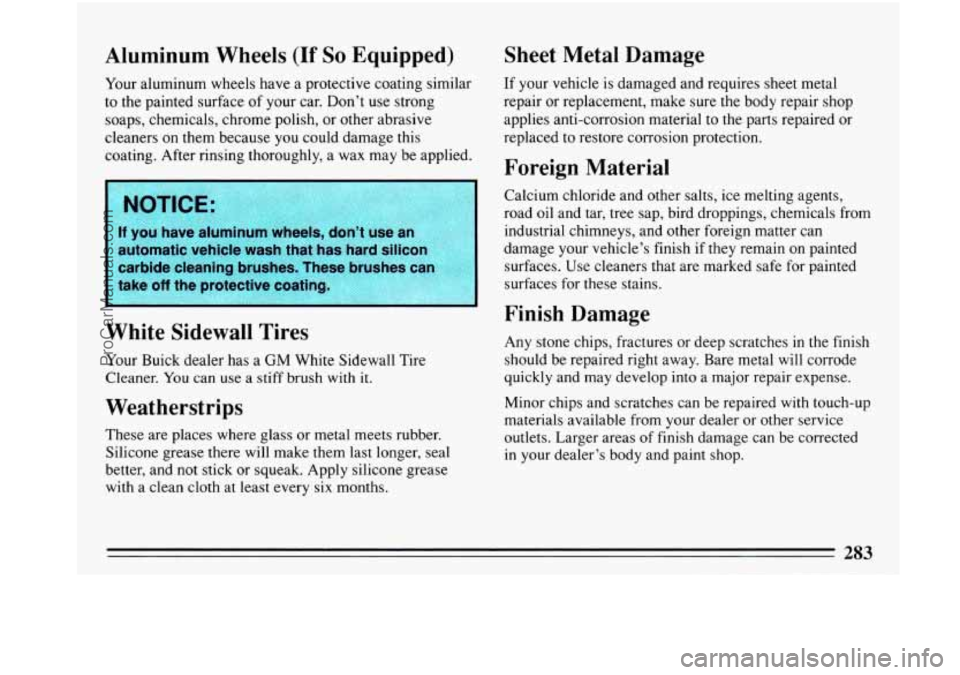
Aluminum Wheels (If So Equipped)
Your aluminum wheels have a protective coating similar
to the painted surface
of your car. Don’t use strong
soaps, chemicals, chrome polish, or other abrasive
cleaners on them because
you could damage this
coating. After rinsing thoroughly, a wax may be applied.
I NOTICE:
If you have aluminum wheels, don’t use an
automatic vehicle wash that has hard silicon
carbide cleaning brushes. These brushes can
take
off the protective coating.
White Sidewall Tires
Your Buick dealer has a GM White Sidewall Tire
Cleaner. You can use a stiff brush with
it.
Weatherstrips
These are places where glass or metal meets rubber.
Silicone grease there will make them last longer, seal
better, and not stick or squeak. Apply silicone grease
with a clean cloth at least every six months.
Sheet Metal Damage
If your vehicle is damaged and requires sheet metal
repair or replacement, make sure the body repair shop
applies anti-corrosion material to the parts repaired or
replaced to restore corrosion protection.
Foreign Material
Calcium chloride and other salts, ice melting agents,
road oil and tar, tree sap, bird droppings, chemicals from
industrial chimneys, and other foreign matter can
damage your vehicle’s finish if they remain on painted
surfaces.
Use cleaners that are marked safe for painted
surfaces for these stains.
Finish Damage
Any stone chips, fractures or deep scratches in the finish
should be repaired right away. Bare metal will corrode
quickly and may develop into a major repair expense.
Minor chips and scratches can be repaired with touch-up
materials available from your dealer or other service
outlets. Larger areas of finish damage can be corrected
in your dealer’s body and paint shop.
ProCarManuals.com
Page 286 of 340
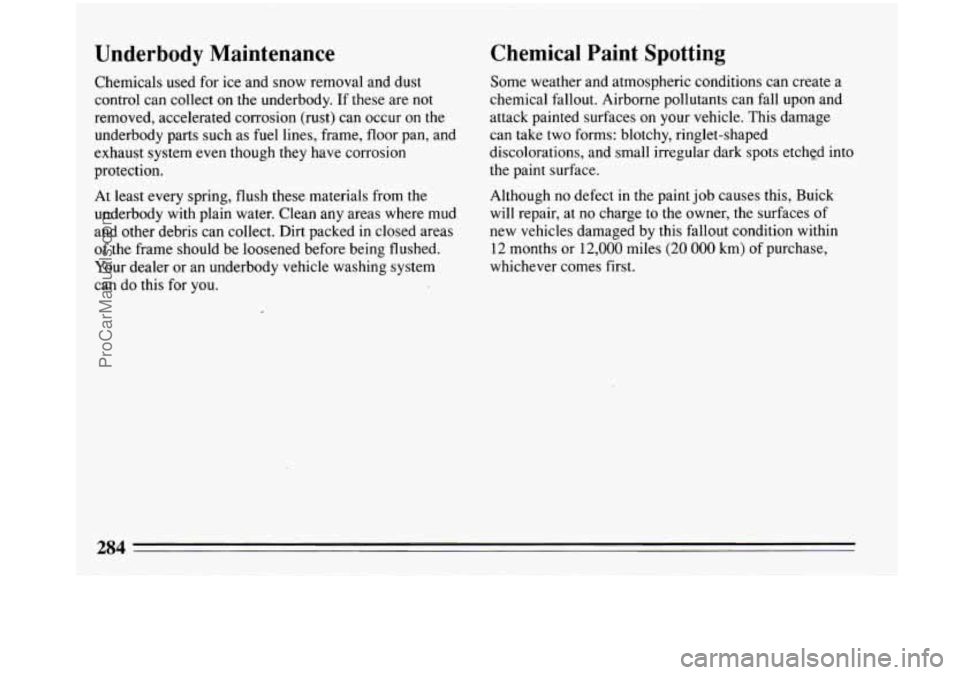
Underbody Maintenance
Chemicals used for ice and snow removal and dust
control can collect on
the underbody. If these are not
removed, accelerated corrosion (rust) can occur on the
underbody parts such as fuel lines, frame, floor pan, and
exhaust system even though they have corrosion
protection.
At least every spring, flush these materials from the
underbody with plain water. Clean any areas where mud
and other debris can collect. Dirt packed in closed areas
of the frame should be loosened before being flushed.
Your dealer or
an underbody vehicle washing system
can do this for you.
Chemical Paint Spotting
Some weather and atmospheric conditions can create a
chemical fallout. Airborne pollutants can fall upon and
attack painted surfaces on your vehicle. This damage
can take two forms: blotchy, ringlet-shaped
discolorations, and small irregular dark spots etchgd into
the paint surface.
Although no defect
in the paint job causes this, Buick
will repair, at no charge to the owner, the surfaces
of
new vehicles damaged by this fallout condition within
12 months or 12,000 miles (20
000 km) of purchase,
whichever comes first.
ProCarManuals.com
Page 287 of 340
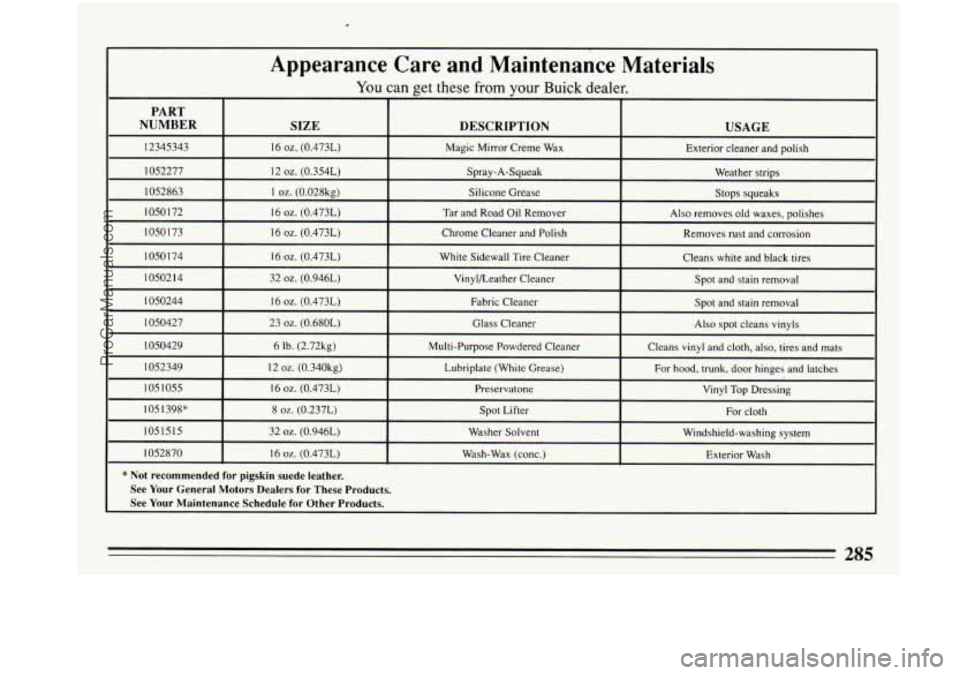
Appearance Care and Maintenance Materials
You can get these from your Buick dealer.
* Not recommended for pigskin suede leather.
See Your General Motors Dealers for These Products.
See Your Maintenance Schedule for Other Products.
ProCarManuals.com
Page 288 of 340

Vehicle Identification Number (VIN)
II ID BllHlll1111111 IIIIIM 1111 1111 111 llllllll1111111111111111 I=
m, SAMPLE4UXPM072675
ENGINE A93 ASSEMBLY
CODE MODEL YEAR PLANT
This is the legal identifier for your Buick. It appears on
a plate in the front corner of the instrument panel, on the
driver’s side. You can see it
if you look through the
windshield from outside your vehicle. The VIN also
appears on the Vehicle Certification and Service Parts
labels and the certificates
of title and registration.
Engine Identification
The eighth character in your VIN is the engine code for
your
GM engine. This code will help you identify your
engine, specifications, and replacement parts in this
section.
Service Parts Identification Label
You’ll find this label on the spare tire cover. It’s very
helpful if you ever need to order parts. On this label is:
0 Your VIN.
0 Its model designation.
0 Paint information.
0 A list of all production options and special
Be sure that this label is not removed from the vehicle.
equipment.
Add-on
Electrical Equipment
I NOTICE:
Don’t add anything electrical to your Buick
unless you check with your dealer first. Some
~ electrical equipment can damage your vehicle
and the damage wouldn’t be covered by your
~ warranty. Some of it can just keep other things
~ from working as they should.
ProCarManuals.com
Page 289 of 340
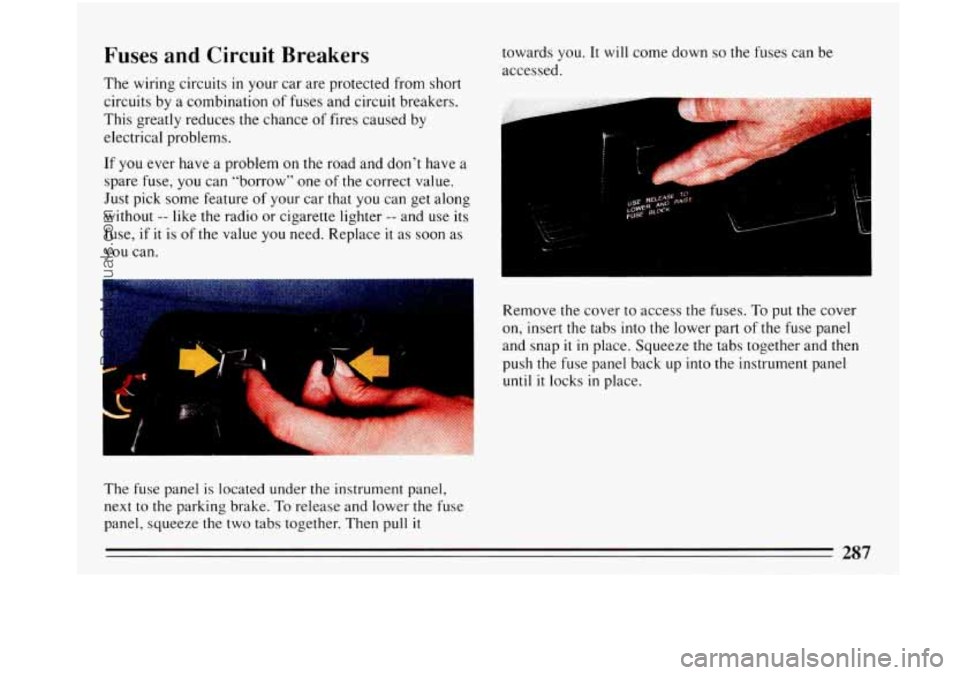
Fuses and Circuit Breakers
The wiring circuits in your car are protected from short
circuits by a combination of fuses and circuit breakers.
This greatly reduces the chance of fires caused by
electrical problems.
If you ever have a problem on the road and don’t have a
spare fuse, you can “borrow” one of the correct value.
Just pick some feature
of your car that you can get along
without
-- like the radio or cigarette lighter -- and use its
fuse,
if it is of the value you need. Replace it as soon as
you can.
tl R
towards you. It will come down so the fuses can be
accessed.
Remove the cover to access the fuses.
To put the cover
on, insert the tabs into the lower part of the fuse panel
and snap
it in place. Squeeze the tabs together and then
push the fuse panel back up into the instrument panel
until it locks in place.
The fuse panel
is located under the instrument panel,
next to the parking brake.
To release and lower the fuse
panel, squeeze
the two tabs together. Then pull it
287
ProCarManuals.com
Page 290 of 340
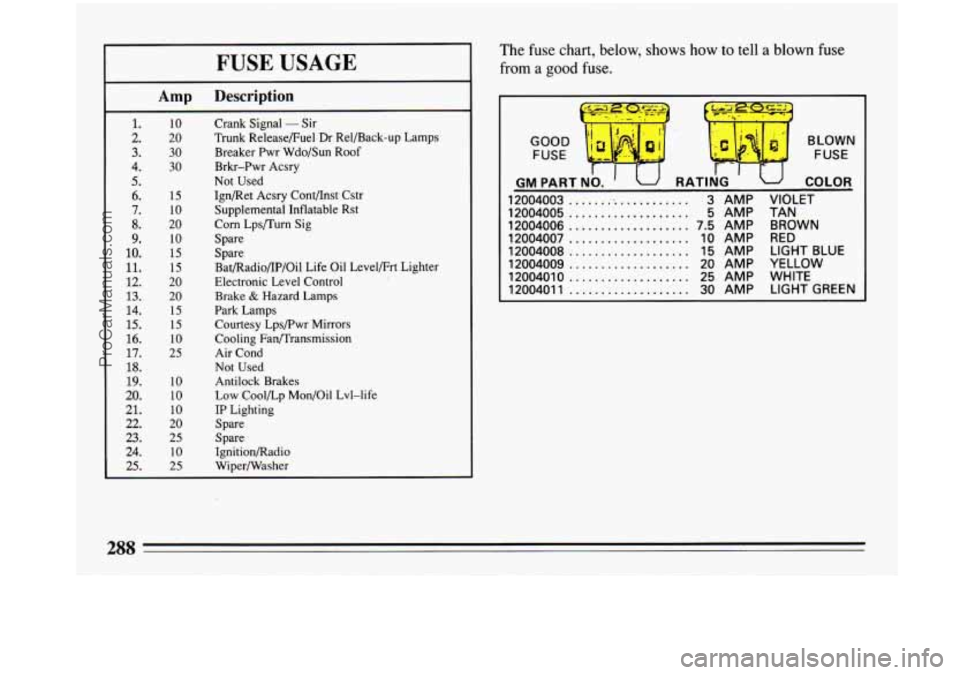
FUSE USAGE
Amp Description
1.
2.
3.
4.
5. 6.
7.
8.
9.
10.
11. 12.
13.
14.
15.
16. 17.
18.
19.
20.
21.
22.
23.
24.
25.
10
20
30
30
15
10
20
10
15
15
20
20
15
15
10
25
10
10
10
20
25
10
25
Crank Signal - Sir
Trunk Release/Fuel.Dr Rel/Back-up Lamps
Breaker Pwr Wdo/Sun Roof
Brkr-Pwr Acsry
Not Used
Ign/Ret Acsry ContDnst Cstr
Supplemental Inflatable Rst
Corn Lps/Turn Sig
Spare
Spare
Bat/Radio/IP/Oil Life Oil Level/Frt Lighter
Electronic Level Control
Brake
& Hazard Lamps
Park Lamps
Courtesy Lps/Pwr Mirrors
Cooling Fan/Transmission
Air Cond
Not Used
Antilock Brakes
Low Cool/Lp Mon/Oil Lvl-life
IP Lighting
Spare
Spare
IgnitionBadio
Wiperwasher
The fuse chart, below, shows how to tell a blown fuse
from a
good fuse.
GOOD
FUSE 1 BLOWN .r, ' \' gJ
'TI r
FUSE
GM PART NO. ' RATING ' COLOF
12004003 .................... 3 AMP VIOLET
12004005
................... 5 AMP TAN
12004006
................... 7.5 AMP BROWN
12004007
................... 10 AMP RED
12004008
................... 15 AMP LIGHT
BLUE
12004009
................... 20 AMP YELLOW
12004010
................... 25 AMP WHITE
1200401
1 ................... 30 AMP LIGHT
GREEN
ProCarManuals.com